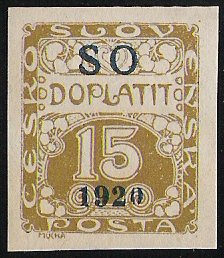Stamp: Postage Due - overprint S O 1920 (Czechoslovakia 1920)
Postage Due - overprint S O 1920 (Czechoslovakia 1920)
13 February (Czechoslovakia ) within release POŠTA V PLEBISCITNÍM ÚZEMÍ VÝCHODNÍHO SLEZSKA, ORAVY A spíše goes into circulation Stamp Postage Due - overprint S O 1920 face value 15 Czechoslovak haléř
| Stamp Postage Due - overprint S O 1920 in catalogues | |
|---|---|
| Michel: | Mi:CS-SO P3 |
| Yvert et Tellier: | Yt:CS-SO T3 |
| POFIS: | POF:CS-SO 35 |
Stamp is square format.
SO 1920Also in the issue POŠTA V PLEBISCITNÍM ÚZEMÍ VÝCHODNÍHO SLEZSKA, ORAVY A spíše:
- Stamp - Hradcany at Prague - overprint S O 1920 face value 3;
- Stamp - Hradcany at Prague - overprint S O 1920 face value 5;
- Stamp - Hradcany at Prague - overprint S O 1920 face value 10;
- Stamp - Hradcany at Prague - overprint S O 1920 face value 15;
- Stamp - Hradcany at Prague - overprint S O 1920 face value 20;
- Stamp - Hradcany at Prague - overprint S O 1920 face value 20;
- Stamp - Hradcany at Prague - overprint S O 1920 face value 25;
- Stamp - Hradcany at Prague - overprint S O 1920 face value 30;
- Stamp - Hradcany at Prague - overprint S O 1920 face value 30;
- Stamp - Hradcany at Prague - overprint S O 1920 face value 40;
- Stamp - Hradcany at Prague - overprint S O 1920 face value 50;
- Stamp - Hradcany at Prague - overprint S O 1920 face value 50;
- Stamp - Hradcany at Prague - overprint S O 1920 face value 60;
- Stamp - Hradcany at Prague - overprint S O 1920 face value 75;
- Stamp - Hradcany at Prague - overprint S O 1920 face value 80;
- Stamp - Hradcany at Prague - overprint S O 1920 face value 100;
- Stamp - Hradcany at Prague - overprint S O 1920 face value 120;
- Stamp - Hradcany at Prague - overprint S O 1920 face value 200;
- Stamp - Hradcany at Prague - overprint S O 1920 face value 300;
- Stamp - Hradcany at Prague - overprint S O 1920 face value 400;
- Stamp - Hradcany at Prague - overprint S O 1920 face value 500;
- Stamp - Hradcany at Prague - overprint S O 1920 face value 1000;
- Stamp - Tomáš Garrigue Masaryk, president - overprint S O1920 face value 500;
- Stamp - Tomáš Garrigue Masaryk, president - overprint S O1920 face value 1000;
- Stamp - Special Delivery Stamp (express) - overprint S O 1920 face value 2;
- Stamp - Special Delivery Stamp (express) - overprint S O 1920 face value 5;
- Stamp - Sokol v letu - Windhover - overprint S O 1920 face value 2;
- Stamp - Sokol v letu - Windhover - overprint S O 1920 face value 6;
- Stamp - Sokol v letu - Windhover - overprint S O 1920 face value 10;
- Stamp - Sokol v letu - Windhover - overprint S O 1920 face value 20;
- Stamp - Sokol v letu - Windhover - overprint S O 1920 face value 30;
- Stamp - Postage Due - overprint S O 1920 face value 5;
- Stamp - Postage Due - overprint S O 1920 face value 10;
- Stamp - Postage Due - overprint S O 1920 face value 15;
- Stamp - Postage Due - overprint S O 1920 face value 20;
- Stamp - Postage Due - overprint S O 1920 face value 25;
- Stamp - Postage Due - overprint S O 1920 face value 30;
- Stamp - Postage Due - overprint S O 1920 face value 40;
- Stamp - Postage Due - overprint S O 1920 face value 50;
- Stamp - Postage Due - overprint S O 1920 face value 100;
- Stamp - Postage Due - overprint S O 1920 face value 500;
- Stamp - Postage Due - overprint S O 1920 face value 1000;
Stamp Postage Due - overprint S O 1920 it reflects the thematic directions:
A number is a mathematical object used to count, measure, and label. The most basic examples are the natural numbers 1, 2, 3, 4, and so forth. Numbers can be represented in language with number words. More universally, individual numbers can be represented by symbols, called numerals; for example, "5" is a numeral that represents the number five. As only a relatively small number of symbols can be memorized, basic numerals are commonly organized in a numeral system, which is an organized way to represent any number. The most common numeral system is the Hindu–Arabic numeral system, which allows for the representation of any non-negative integer using a combination of ten fundamental numeric symbols, called digits. In addition to their use in counting and measuring, numerals are often used for labels (as with telephone numbers), for ordering (as with serial numbers), and for codes (as with ISBNs). In common usage, a numeral is not clearly distinguished from the number that it represents.

